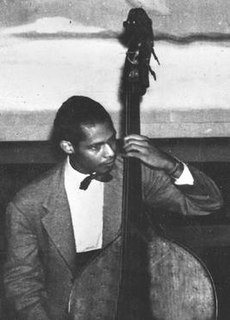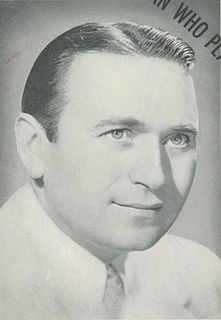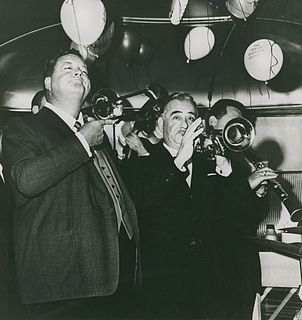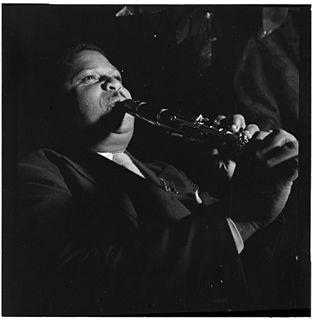
Jimmy Butts (September 24, 1917 – January 8, 1998) was an American jazz double-bassist.
Jazz is a music genre that originated in the African-American communities of New Orleans, United States, in the late 19th and early 20th centuries, and developed from roots in blues and ragtime. Jazz is seen by many as "America's classical music". Since the 1920s Jazz Age, jazz has become recognized as a major form of musical expression. It then emerged in the form of independent traditional and popular musical styles, all linked by the common bonds of African-American and European-American musical parentage with a performance orientation. Jazz is characterized by swing and blue notes, call and response vocals, polyrhythms and improvisation. Jazz has roots in West African cultural and musical expression, and in African-American music traditions including blues and ragtime, as well as European military band music. Intellectuals around the world have hailed jazz as "one of America's original art forms".
Early in his career Butts played with local groups Dr. Sausage and His Pork Chops and Daisy Mae's Hepcats. Early in the 1940s he played in the orchestras of Les Hite and Chris Columbus. He accompanied Frances Brock on USO tours during World War II, and also played with Don Redman, Art Hodes, Lem Johnson, Tiny Grimes, and Noble Sissle in the 1940s. Late in the decade he played in a duo with Doles Dickens and had his own ensemble, continuing with it into the early 1950s.
Lucius Antoine Tyson, who performed as Dr. Sausage or Doc Sausage, was an American singer, dancer, drummer and bandleader. He was active from the 1930s to the 1950s and is best known for his 1950 recording of "Rag Mop".
Les Hite was an American jazz bandleader.
Joseph Christopher Columbus Morris, better known as Crazy Chris Columbo, was an American jazz drummer. He was sometimes credited as Joe Morris on record, though he is no relation to free jazz guitarist Joe Morris or trumpeter Joe Morris.
In the 1960s Butts emigrated to Canada, where he played with Juanita Smith. In the 1970s he returned to New York City and played with his own small group, working almost up until his death. His band remained together under the name Friends of Jimmy Butts after his death.

Canada is a country in the northern part of North America. Its ten provinces and three territories extend from the Atlantic to the Pacific and northward into the Arctic Ocean, covering 9.98 million square kilometres, making it the world's second-largest country by total area. Canada's southern border with the United States is the world's longest bi-national land border. Its capital is Ottawa, and its three largest metropolitan areas are Toronto, Montreal, and Vancouver. As a whole, Canada is sparsely populated, the majority of its land area being dominated by forest and tundra. Consequently, its population is highly urbanized, with over 80 percent of its inhabitants concentrated in large and medium-sized cities, many near the southern border. Canada's climate varies widely across its vast area, ranging from arctic weather in the north, to hot summers in the southern regions, with four distinct seasons.

The City of New York, usually called either New York City (NYC) or simply New York (NY), is the most populous city in the United States. With an estimated 2017 population of 8,622,698 distributed over a land area of about 302.6 square miles (784 km2), New York is also the most densely populated major city in the United States. Located at the southern tip of the state of New York, the city is the center of the New York metropolitan area, the largest metropolitan area in the world by urban landmass and one of the world's most populous megacities, with an estimated 20,320,876 people in its 2017 Metropolitan Statistical Area and 23,876,155 residents in its Combined Statistical Area. A global power city, New York City has been described as the cultural, financial, and media capital of the world, and exerts a significant impact upon commerce, entertainment, research, technology, education, politics, tourism, art, fashion, and sports. The city's fast pace has inspired the term New York minute. Home to the headquarters of the United Nations, New York is an important center for international diplomacy.
















